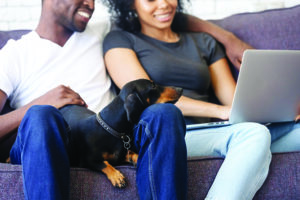
The term “decompression” has become popular in dog training and behavior circles. A strict definition of the word references the process of releasing or reducing pressure. In the dog world, we use the term in a behavioral context to describe the process of reducing a dog’s stress – mental pressure – which often gets inflated by being put through a number of environmental changes. Sometimes, the changes that dogs experience as they make their way from their birthplace to their would-be “forever home” are tremendous. I’m thinking of dogs who were born on the street in countries that are very different from ours and then captured, transported on airplanes, quarantined for a period, and housed in foster situations before being made available for adoption. But even dogs who lived in just one home before finding themselves in a shelter or being given to someone else often are often overwhelmed with the changes in their lives. Often, the dog’s circumstances are changed for the better when she’s rehomed. But it’s undeniable that the stress of these moves can hinder and delay the dog’s adjustment to her new life. I hope that understanding how this stress affects your new dog can help you dedicate yourself to the process of helping her settle smoothly into your home and bond with your family.
WHAT STRESS LOOKS LIKE
Stress-related behaviors can range from “shutting down” to being fearful, vocal, destructive, ill-mannered, or aggressive. The expression “shut down” is often used to describe a dog who is behaving in an abnormally inactive or unresponsive way. Many dogs are shut down to at least some degree when they first arrive in their new homes, especially if they are shell-shocked from the stress of being in a shelter or crowded rescue facility long-term. The most severely shut-down dogs may appear near-catatonic – unwilling at first to even move, eat, drink, urinate, or defecate. Less severe cases may appear deceptively well-behaved, showing their real personalities and behaviors only after being in their new world long enough to let down their guard. So how do you tell the difference between a stressed, shut-down dog and a naturally calm, well-behaved dog? The truly calm dog will have soft, relaxed body language and clearly enjoy her interactions with you. The “well-behaved” stressed (shut-down) dog will be stiffer in her movements, is likely to have a look of caution in her eyes, and will perhaps tolerate your interactions but not truly enjoy them. She may not pay much attention to you or your family members at first, avoiding eye contact, declining your invitations to interact, and seeming to not particularly enjoy being petted. Again, though your new dog may seem “well behaved,” you should be aware that this is not necessarily an indication that she knows not to get into the kitchen garbage, chew up sofas, chase the cat, etc. She may be too intimidated or anxious about offering any behaviors that might have resulted in punishment in her past. Or, she might simply be observing the household and deciding whether it’s safe to move around freely.

One of the first versions I saw of a decompression protocol presented the “3-3-3 Rule,” which basically says the dog is likely to be pretty much shut down for the first three days, require another three weeks to settle in and develop a routine, and a total of three months to become completely comfortable in a new home. Though I appreciate that the intention of this formula was to encourage owners to give their new dogs time before they imposed behavioral expectations on the dogs, I took an immediate dislike to this 3-3-3 decompression “formula.” Dogs are not machines, and they do not follow a set formula. I have known dogs who seemed at home as soon as they set foot in the door, dogs who have settled in well before three weeks, and dogs who were completely comfortable long before three months are up. At the other end of the scale, I’ve known dogs who were shut down for weeks, even months, and who were not “completely comfortable” in their own homes even after a year. That doesn’t mean I don’t like the idea of decompression for your new dog. I like it very much. I just strongly dislike any behavior protocol that offers fixed guidelines and timelines. Again, it’s great that people are even discussing decompression for adopted dogs – but, my oh my, some of the advice being given to supposedly help a dog decompress is awful! An internet search on “dog decompression” offers a wide range of suggestions, including one site that advocates two weeks of “crate and rotate” where any other household dogs are kept crated any time the new dog is out of her crate. This site suggests that dogs can go on walks together (but kept a distance apart) after the first week but should not even be allowed to interact with each other for at least the first two weeks. Really? I have added more than 20 new dogs to my family during my adult years (and fostered quite a few more). All of them have fully integrated into my canine household well before two weeks were up, and many of them were interacting easily with each other on Day One. Another piece of bad advice I see frequently is to crate your new dog – a lot – starting on Day One. The problem here is that many dogs come to their new homes without prior crate training, and while some dogs will adapt rapidly and readily to the idea of crating, many will not. You will only add stress to your new dog’s life – possibly considerable stress –and potentially create a significant behavior problem, if you just shove her into a crate on Day One and expect her to stay there for hours at a time. If I have a set formula for helping a dog decompress, it’s to be patient and treat her as the individual she is, giving her time to get to know and trust you, without the expectation of a specific deadline for various behavioral milestones.
WHAT DECOMPRESSION MAY LOOK LIKE
As a shut-down dog grows more comfortable in her new home, and her stress-increased high cortisol levels begin to decrease, she may start to display more behavior. She may sleep or rest less and explore and interact more with the other members of her household. This may be a great thing – she’s happy! She feels confident about coming to you and asking for affection and attention. That’s good. However, the increase in her activity may look like a bad thing! No longer inhibited by fear or feeling paralyzed by chronic stress, your new dog may spontaneously chase the cat or jump up on the counter to see what’s up there. She might start barking at every sound coming from the other side of your backyard fences. This doesn’t mean she’s bad, spiteful, acting out, or any of the other pejoratives I’ve heard overwhelmed owners assigning to their new dogs. These behaviors are actually a sign that the dog is finally feeling less inhibited and showing you the true extent of her understanding of how to live with humans! It also means you have some work to do, including managing her environment so that she doesn’t get reinforced for those behaviors.
HOW TO DECOMPRESS
Remember, every dog is an individual. Planning a decompression protocol for a new dog completely depends on the dog and her response to her introduction to her new world. Here are the general decompression guidelines that I suggest:

1. Don’t rush your dog’s initial arrival. When you first arrive home with your new dog, start by taking her for a walk – on leash – around your yard before even bringing her into your house. If you don’t have a yard, walk her in the quietest area of your neighborhood that you can find. This is to give her a chance to settle and relax from the tension of the ride home, as well as the stress of the environment she was in before the car ride (especially if she was in a shelter or crowded rescue facility). During this first walk, encourage her to eliminate. If you want her to use a designated bathroom spot in your yard, take her there and hang out for a while. If you have other dogs who use this area as their bathroom, the scent will help prompt her to eliminate there. Spend a good bit of time in this bathroom area, just relaxing, not hurrying anything. This will allow your new dog to really take in the sights and smells of this spot, and hopefully relax enough to eliminate there. Take as much time as she needs so you can reinforce that behavior and so when you take her into the house, she doesn’t have a full bladder or bowel, which would likely be an additional stressor for her. If you have other dogs, close them in a back room or put them out in the yard before you bring your new dog into your house. Still on leash, give her a tour of her new home, allowing her as much time as she wants to sniff and explore. Keep your other dogs separated until you see signs that she’s relaxed and actively interested in finding and meeting her new canine family members; this may take minutes, hours, or days, depending on her level of fear and past experiences! During this time, do not allow her to be overwhelmed by family members (especially children). To avoid additional stressors, it’s also best not to have visitors at this time. 2. Watch her for signs of stress. These may include panting, salivating, a lowered body posture, tucked tail, flattened ears, trembling, yawning, trying to escape, and more. Is she reluctant to move? Does she startle when a car passes or when she hears a dog bark? Does she freeze when a human approaches? If so, restrict your activities to low-stimulus ones. Keep visitors to your house at a minimum. On walks, spend time just standing still until she is willing to move, and wrap her in virtual bubble-wrap: assertively preventing anyone from approaching, and walking away from anything that might worry her. Make note of your dog’s stress behaviors, ideally in a journal that you maintain for at least her first few weeks with you. Watch for these behaviors to decrease over time – this will tell you that decompression is working. If they stay at the same level, or worse, increase, seek professional assistance to help her adjust to her life with you. 3. For at least the first day or two, try to arrange to have someone with her at all times until you can gradually help her adjust to being alone. It’s not uncommon for dogs to experience distress when they are first left alone in their new home. If you can avoid leaving her home alone until she is comfortable and familiar with her new surroundings, it may forestall triggering your still-stressed dog into an isolation-induced panic. If your dog was previously an “outdoor dog,” and she seems less stressed in your yard than in your house, leaving her in the safely fenced yard for periods of time can also help reduce her stress. Watch her closely the first several times you do this to be sure she isn’t a climber, jumper, or digger – you don’t want her to Houdini out of the yard and vanish into the sunset; that could be why she ended up in a shelter in the first place! If your dog is significantly stressed about being left alone in the yard or in the house (crying, howling, trying to dig or chew her way out), crated or not, she may have some degree of isolation or separation distress, and you will have some work to do. Depending on the severity of her distress, you may not be able to leave her alone at all until her behavior is modified, and you may need to consult a qualified behavior professional or veterinary behaviorist. (Here are two great sources for help: malenademartini.com/about/meet-your-team/ and subthresholdtraining.com/find-a-trainer.) For more information, see “Separation Anxiety in Dogs,” WDJ October 2016. 4. Establish a routine early, during the first few days of her new life with you. Knowing what to expect will help her relax and settle in. Have treats in your pockets at all times, and be prepared to create positive associations by feeding her treats anytime you notice her concerned by household sounds, activities, etc. If she’s allowed on the furniture, fine; you can invite her up from the get-go. If she’s not going to be allowed on the furniture, don’t feel sorry for her and let her jump up the first few days only to forbid her from getting on the sofa later. Be sure to use management (such as baby gates, tethers, and closed doors) and positive reinforcement to implement house rules rather than verbal or physical punishment. If she jumps onto a forbidden sofa, toss a treat away from the sofa and encourage her to “Find it!” Then, redirect her to her own soft bed, or gate her out of the living room, so she can’t keep trying to get on the sofa. Note that everyone in the family needs to be on board with the agreed-upon rules. A lack of consistency will keep your dog unsettled and lacking in confidence about what is okay to do and what is not allowed. 5. You can begin training at home (force-free, of course) as soon as your new dog seems receptive to your invitations to perform easy behaviors. For calm, easygoing dogs this might even be on Day One. Others will need a few days or more to be able to focus enough to do any training. Some dogs will be ready to join a training class within a week or two of joining your family, while others may need to wait weeks – or months – before they are ready to join the group class training community. If you want to start training but you know your dog isn’t ready to handle a group training class, consider hiring a professional to do in-home training with you. Read your dog’s behavior signals and develop your training plan accordingly. Your new dog may fit right into your family as if she’s lived there all her life, or you may be challenged by the decompression process. Remember, she may have been through some very tough times before she came to you, and she needs your sympathy and understanding.






I rescued a 4 yr old border terrier who live dear life in an outdoor breeders kennel,she was totally shut down foe 7 months ,now her tail wags,and she interacts with dogs at dog park, but still does not like to sit on my lap ,never licks me, likes the door open to run in and out , not possible in the winter, she knew no commands but now understands the ones she wants to lol ,she barks now it took 6 months, she is starting to act more like a dog and not a lifer on death row, have owned rescues for years but non this bad,she now feels safe with me but although she house trained quickly she has leaked , some days not much other day drip drip drip ,when. She relaxes at my feet being stroked she leaves a puddle, and she still paces a bit she used to do it all day,she never jumps on the furniture to take a nap ? On odd occasions she will jump up and sit on the chair arm but never faces me,,,I love her to death but she still is not like a border terrier should be ,how do I break the habits of 4 yrs of solitude she suffered,I am retired and she loves car rides. Thank you
Thank you for your insight.
My spouse and I adopted an 8 year old shepherd mix (going on 3 months now) and Vegas started barking at my spouse.
She can just leave the room a couple minutes and Vegas barks at her like “stranger” (not aggresive), and whenever she makes a quick movement, comes in the house without me, etc.
what do we do – will Vegas stop. oh the dog did not start barking at her until her mom came over for a visit and Vegas started.